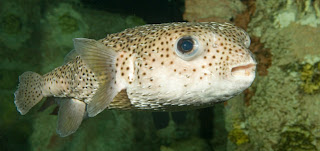There are 121 species of Pufferfish, found within 20 separate genera, but all contained within the family Tetraodontidae. They lived in tropical waters throughout the world, and some species have even made it to temperate areas and fresh water. Pufferfish can grow to a variety of different sizes, depending on the species, with the largest individuals reaching about 40in in length. All Pufferfish have a similar long, tapered body shape and round head. Their family name, Tetraodontidae, comes from their four large, fused teeth that allow them to
break open the hard shells of mollusks and crustaceans.
So how does a Pufferfish puff? Because they swim so slowly, Pufferfish are unable to quickly escape from would be predators. They have developed extremely
elastic stomachs and the ability to very quickly suck in water (and sometimes air) in order to inflate themselves to a much large size. Most Pufferfish also have spines that remain hidden while deflated, but project outward while puffed up, giving them an even more fearsome appearance.
But inflation is not the only trick a Pufferfish has up its sleeve. Nearly every species contains a powerful substance known as
Tetrodotoxin, which if found chiefly in organs like the ovaries and liver. It is extremely potent, and in humans is over 1,000 times more powerful than Cyonide. Yet humans still eat Pufferfish! The meat of these fish, sometimes called
Fugu, is considered a delicacy in Japan. If prepared correctly by a trained chef, the meat is harmless. Still, every year their are reported cases of poisoning, and there is no antidote. While this toxin is deadly to humans, some marine predators, including Tiger Sharks, are unaffected.




Comments
Post a Comment